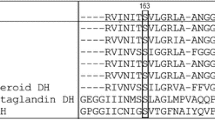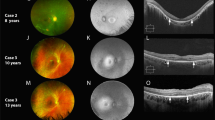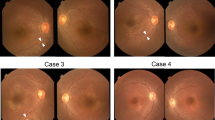Abstract
The aim of this study was to describe multimodal retinal imaging of fundus albipunctatus (FA) with the newly identified compound heterozygous RDH5 mutation and to review the relevant literature. Five family members were examined, and the RDH5 gene was analyzed by direct sequencing. The clinical features and genetic study of FA are reviewed. The proband had a compound heterozygotic missense mutation of Cys59Ser (TGC → AGC) and a nonsense mutation of Trp95ter (TGG → TGA) in the RDH5 gene. Fundus examination revealed diffuse yellow flecks with foveal sparing. Infrared reflectance (IR) imaging showed multiple discrete round lesions, and fundus autofluorescence (FAF) imaging showed decreased autofluorescence. In spectral domain optical coherence tomography (SD-OCT), the lesions spanned across the retinal pigment epithelium complex and the photoreceptor inner segment ellipsoid band. The outer nuclear layer thickness is decreased compared to normal control. Electroretinography (ERG) showed improved dark-adapted responses after a prolonged 2.5-h dark adaptation. The fundi of the patient’s son and daughter both appeared unremarkable. The clinical findings, differential diagnosis, and genetic studies of these features are reviewed. This is the first time that IR imaging of this disease has been reported; IR imaging showed more detail than did FAF imaging. Although retinal imaging (fundus photographs, FAF, IR, SD-OCT) of FA showed characteristic findings, ERG and genetic study remain the most reliable tests for making the diagnosis.






Similar content being viewed by others
References
Mooren A (1882) Fünf Lustren Ophthalmologische Wirksamkeit. Verlag Von J. F, Bergmann
Lauber H (1910) Die sogenannte Retinitis punctata albescens. Klin Monatsbl Augenheilkd 48:133–148
Yamamoto H, Simon A, Eriksson U, Harris E, Berson EL, Dryja TP (1999) Mutations in the gene encoding 11-cis retinol dehydrogenase cause delayed dark adaptation and fundus albipunctatus. Nat Genet 22:188–191
Krill AE, Folk MR (1962) Retinitis punctata albescens. A functional evaluation of an unusual case. Am J Ophthalmol 53:450–455
Krill AE (1977) Krill’s hereditary retinal and choroidal diseases, vol 1. Harper & Row Hagerstown, MD
Simon A, Hellman U, Wernstedt C, Eriksson U (1995) The retinal pigment epithelial-specific 11-cis retinol dehydrogenase belongs to the family of short chain alcohol dehydrogenases. J Biol Chem 270:1107–1112
Driessen CA, Janssen BP, Winkens HJ, van Vugt AH, de Leeuw TL, Janssen JJ (1995) Cloning and expression of a cDNA encoding bovine retinal pigment epithelial 11-cis retinol dehydrogenase. Invest Ophthalmol Vis Sci 36:1988–1996
Schmitz-Valckenberg S, Holz FG, Bird AC, Spaide RF (2008) Fundus autofluorescence imaging: review and perspectives. Retina 28:385–409
Wang NK, Fine HF, Chang S, Chou CL, Cella W, Tosi J, Lin CS, Nagasaki T, Tsang SH (2009) Cellular origin of fundus autofluorescence in patients and mice with a defective NR2E3 gene. Br J Ophthalmol 93:1234–1240
Morimura H, Berson EL, Dryja TP (1999) Recessive mutations in the RLBP1 gene encoding cellular retinaldehyde-binding protein in a form of retinitis punctata albescens. Invest Ophthalmol Vis Sci 40:1000–1004
Hood DC, Zhang X, Ramachandran R, Talamini CL, Raza A, Greenberg JP, Sherman J, Tsang SH, Birch DG (2011) The inner segment/outer segment border seen on optical coherence tomography is less intense in patients with diminished cone function. Invest Ophthalmol Vis Sci 52:9703–9709
Wang NK, Lai CC, Chu HY, Chen YP, Chen KJ, Wu WC, Yeh LK, Chuang LH, Chen TL (2012) Classification of early dry-type myopic maculopathy with macular choroidal thickness. Am J Ophthalmol 153:669–677, 677.e1–2
Marmor MF, Fulton AB, Holder GE, Miyake Y, Brigell M, Bach M (2009) ISCEV standard for full-field clinical electroretinography (2008 update). Doc Ophthalmol 118:69–77
Sergouniotis PI, Sohn EH, Li Z, McBain VA, Wright GA, Moore AT, Robson AG, Holder GE, Webster AR (2011) Phenotypic variability in RDH5 retinopathy (fundus albipunctatus). Ophthalmology 118:1661–1670
Nakamura M, Skalet J, Miyake Y (2003) RDH5 gene mutations and electroretinogram in fundus albipunctatus with or without macular dystrophy: RDH5 mutations and ERG in fundus albipunctatus. Doc Ophthalmol 107:3–11
Nakamura M, Hotta Y, Tanikawa A, Terasaki H, Miyake Y (2000) A high association with cone dystrophy in Fundus albipunctatus caused by mutations of the RDH5 gene. Invest Ophthalmol Vis Sci 41:3925–3932
Miyake Y, Shiroyama N, Sugita S, Horiguchi M, Yagasaki K (1992) Fundus albipunctatus associated with cone dystrophy. Br J Ophthalmol 76(6):375–379
Marmor MF (1977) Fundus albipunctatus: a clinical study of the fundus lesions, the physiologic deficit, and the vitamin A metabolism. Doc Ophthalmol 43:277–302
Genead MA, Fishman GA, Lindeman M (2010) Spectral-domain optical coherence tomography and fundus autofluorescence characteristics in patients with fundus albipunctatus and retinitis punctata albescens. Ophthalmic Genet 31:66–72
Querques G, Carrillo P, Querques L, Bux AV, Del Curatolo MV, Delle Noci N (2009) High-definition optical coherence tomographic visualization of photoreceptor layer and retinal flecks in fundus albipunctatus associated with cone dystrophy. Arch Ophthalmol 127:703–706
Schatz P, Preising M, Lorenz B, Sander B, Larsen M, Rosenberg T (2011) Fundus albipunctatus associated with compound heterozygous mutations in RPE65. Ophthalmology 118:888–894
Schatz P, Preising M, Lorenz B, Sander B, Larsen M, Eckstein C, Rosenberg T (2010) Lack of autofluorescence in fundus albipunctatus associated with mutations in RDH5. Retina 30:1704–1713
Franceschetti A, Dieterle P, Ammann F, Marty F (1963) A new form of fundus albipunctatus with hemeralopia. Ophthalmologica 145:403–410
Margolis S, Siegel IM, Ripps H (1987) Variable expressivity in fundus albipunctatus. Ophthalmology 94:1416–1422
Hajali M, Fishman GA, Dryja TP, Sweeney MO, Lindeman M (2009) Diagnosis in a patient with fundus albipunctatus and atypical fundus changes. Doc Ophthalmol 118:233–238
Fishman GA, Roberts MF, Derlacki DJ, Grimsby JL, Yamamoto H, Sharon D, Nishiguchi KM, Dryja TP (2004) Novel mutations in the cellular retinaldehyde-binding protein gene (RLBP1) associated with retinitis punctata albescens: evidence of interfamilial genetic heterogeneity and fundus changes in heterozygotes. Arch Ophthalmol 122:70–75
Granse L, Abrahamson M, Ponjavic V, Andreasson S (2001) Electrophysiological findings in two young patients with Bothnia dystrophy and a mutation in the RLBP1 gene. Ophthalmic Genet 22:97–105
Katsanis N, Shroyer NF, Lewis RA, Cavender JC, Al-Rajhi AA, Jabak M, Lupski JR (2001) Fundus albipunctatus and retinitis punctata albescens in a pedigree with an R150Q mutation in RLBP1. Clin Genet 59:424–429
Simon A, Romert A, Gustafson AL, McCaffery JM, Eriksson U (1999) Intracellular localization and membrane topology of 11-cis retinol dehydrogenase in the retinal pigment epithelium suggest a compartmentalized synthesis of 11-cis retinaldehyde. J Cell Sci 112:549–558
Krill AE, Klien BA (1965) Flecked retina syndrome. Arch Ophthalmol 74:496–508
Michels RG (1977) Flecked retina syndrome. Int Ophthalmol Clin 17:35–74
Uyemura M (1928) Ueber eine merkwurdige Augenhintergrundveranderung bei zwei Fallen yon idiopathischer Hemeralopie. Klin Monatsbl Augenheilkd 81:471–473
Hing TK (1965) Further contributions to the fundus xerophthalmicus. Ophthalmologica 150:219–238
Levy NS, Toskes PP (1974) Fundus albipunctatus and vitamin A deficiency. Am J Ophthalmol 78:926–929
Isaacs TW, McAllister IL, Wade MS (1996) Benign fleck retina. Br J Ophthalmol 80:267–268
Airiani S, Cella W, Chou CL, Tosi J, Tsang SH (2008) Benign panretinal uniform radial linear-shaped flecks. Clin Exp Ophthalmol 36:891–894
Carr RE, Margolis S, Siegel IM (1976) Fluorescein angiography and vitamin A and oxalate levels in fundus albipunctatus. Am J Ophthalmol 82:549–558
Marmor MF (1990) Long-term follow-up of the physiologic abnormalities and fundus changes in fundus albipunctatus. Ophthalmology 97:380–384
Lorenz B, Wabbels B, Wegscheider E, Hamel CP, Drexler W, Preising MN (2004) Lack of fundus autofluorescence to 488 nanometers from childhood on in patients with early-onset severe retinal dystrophy associated with mutations in RPE65. Ophthalmology 111:1585–1594
Braunstein A, Trief D, Wang NK, Chang S, Tsang SH (2010) Vitamin A deficiency in New York City. Lancet 376:267
Elsner AE, Burns SA, Weiter JJ, Delori FC (1996) Infrared imaging of sub-retinal structures in the human ocular fundus. Vis Res 36:191–205
Anastasakis A, Fishman GA, Lindeman M, Genead MA, Zhou W (2011) Infrared scanning laser ophthalmoscope imaging of the macula and its correlation with functional loss and structural changes in patients with Stargardt disease. Retina 31:949–958
Sparrow JR, Wu Y, Kim CY, Zhou J (2010) Phospholipid meets all-trans-retinal: the making of RPE bisretinoids. J Lipid Res 51:247–261
Zweifel SA, Spaide RF, Yannuzzi LA (2011) Acquired vitelliform detachment in patients with subretinal drusenoid deposits (reticular pseudodrusen). Retina 31:229–234
Niwa Y, Kondo M, Ueno S, Nakamura M, Terasaki H, Miyake Y (2005) Cone and rod dysfunction in fundus albipunctatus with RDH5 mutation: an electrophysiological study. Invest Ophthalmol Vis Sci 46:1480–1485
Driessen CA, Janssen BP, Winkens HJ, Kuhlmann LD, Van Vugt AH, Pinckers AJ, Deutman AF, Janssen JJ (2001) Null mutation in the human 11-cis retinol dehydrogenase gene associated with fundus albipunctatus. Ophthalmology 108:1479–1484
Liden M, Romert A, Tryggvason K, Persson B, Eriksson U (2001) Biochemical defects in 11-cis-retinol dehydrogenase mutants associated with fundus albipunctatus. J Biol Chem 276:49251–49257
Driessen CA, Winkens HJ, Hoffmann K, Kuhlmann LD, Janssen BP, Van Vugt AH, Van Hooser JP, Wieringa BE, Deutman AF, Palczewski K, Ruether K, Janssen JJ (2000) Disruption of the 11-cis-retinol dehydrogenase gene leads to accumulation of cis-retinols and cis-retinyl esters. Mol Cell Biol 20:4275–4287
Nakamura M, Miyake Y (2002) Macular dystrophy in a 9-year-old boy with fundus albipunctatus. Am J Ophthalmol 133:278–280
Nakamura M, Lin J, Miyake Y (2004) Young monozygotic twin sisters with fundus albipunctatus and cone dystrophy. Arch Ophthalmol 122:1203–1207
Acknowledgments
We would like to thank the medical imaging division at Chang Gung Memorial Hospital for their excellent work. NKW is supported by the Taiwan National Science Council (grant number NSC-99-2314-B-182A-029-MY3) and the Chang Gung Memorial Hospital (grant numbers CMRPG 381561~381563 and 391801). The funding organization had no role in the design or conduct of this research.
Author information
Authors and Affiliations
Corresponding author
Rights and permissions
About this article
Cite this article
Wang, NK., Chuang, LH., Lai, CC. et al. Multimodal fundus imaging in fundus albipunctatus with RDH5 mutation: a newly identified compound heterozygous mutation and review of the literature. Doc Ophthalmol 125, 51–62 (2012). https://doi.org/10.1007/s10633-012-9336-z
Received:
Accepted:
Published:
Issue Date:
DOI: https://doi.org/10.1007/s10633-012-9336-z




